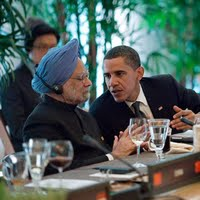With Indian newspapers still carrying obituaries of the country's strategic doyen, K. Subhramanyam, who passed away in February after almost a half-century at the forefront of New Delhi's strategic debates, it is worth considering the object of Subhramanyam's concern during his final days: the implications for India of a proposed U.S.-China grand strategy agreement hammered out by a group of policy experts in Washington and Beijing. The document proposed a series of strategic compromises between China and the U.S., including a massive Chinese investment in the U.S. economy in return for an informal nonaggression pact, particularly with regard to the U.S. military's posture toward China in Taiwan. Indian analysts led by the late Subhramanyam, however, saw the proposal as a ploy by the Chinese to "use the U.S. to attain hegemonic power in Asia."
In the proposal, Subhramanyam heard echoes of the Nixon-Deng compact, born out of the expediency of the Cold War. That agreement saw the United States push huge sums of commercial technology investment into China, ultimately followed by the outsourcing of mass manufacturing. Now, by contrast, it is high technology that would be transferred to China in return for the $1 trillion that Beijing would invest in the U.S. private sector. Over time, these transfers would enable China to leverage its demographic advantages to become the world's dominant economy.
However, Thomas P.M. Barnett, one of the proposal's architects, rejected the significance of China's advantage in absolute demographic numbers. "The volume of bodies no longer determines strength in this world, especially when hundreds of millions of [those bodies] are impoverished, as they are today and will remain for decades in China," said Barnett. "It is much smarter to consider age." As Barnett explained, both China and the United States currently have a median age of 36. But with China aging four times as quickly as the U.S., its median age will hit 48 in 2050, while the U.S. will only have reached 39.

